This complex traditional Persian rich dish combines layers of meat, rice, cabbage, and tomatoes to create an impressive family meal
Ingredients for 8 meals
- 400 Grams red onions chopped in 2-3 mm thick slices
- 600 Grams tomatoes peeled and diced to 1 cm cubes (may use 100 grams tomato paste)
- 800 Grams lamb (or beef), trimmed of extra fats, and chopped to 1-2 cm cubes
- 750 Grams Persian or Basmati rice
- 1 Small cabbage (750 grams) chopped in 2-3 mm thick slices
- 50 Grams butter
- 1 Large potato peeled, sliced in 2-3 mm thickness, and soaked in cold water
- 6 Table spoons cooking oil
- 3 Table spoons salt
- 2 Table spoons dried basil to balance the cabbage taste
- 1 Table spoon general purpose seasoning (See Crispy Fish and Vegetables in my website)
- ¼ Tea spoon saffron powder dissolved in 2 table spoon of hot water
- 1 Tea spoon cumin
- Juice of half a lemon
- 1/2 Tea spoon black pepper (optional)
Directions
Preparations
1 – Wash the rice in a 5-litre skillet 3 to 4 times until clear. Soak in 3-litre of cold water mixed with 2 table spoons of salt and preserve. You may do this step ahead of time and keep the soaked rice in a cool place. The rice has more time to absorb water and salt and becomes tastier.
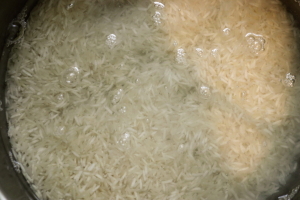
2 – Peel the potato, cut in 2-3 mm thick slices, and soak in cold water to release the excess of starch.

3 – On a cutting board divide the cabbage in smaller and manageable portions, remove the core, and chop to 3 to 4 mm thick slices.
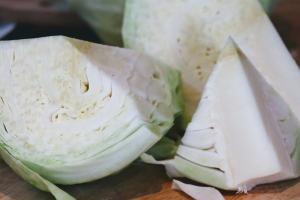
4 -Place the meat on a cutting board, trim extra fats and non-mussel tissues, and chop to 1-2 centimetre cubes.

Sauce
5 – Set the heat to medium, add 3 table spoons of oil in a 5-litre skillet, then add onions. Fry for 5 minutes stirring occasionally until soft. Add seasoning, stir, and let the seasoning flavours to diffuse.
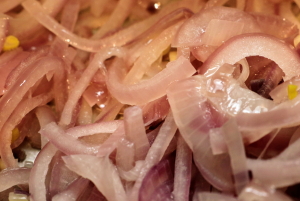
6 – Add the beef to the skillet and cook stirring until browned all around.
7 – Reduce the heat to low, add tomatoes, cabbage, basil, and 1 cup of water. Cover the skillet and cook for at least one hour or until the juices thickens and the meat is cooked. Keep eye on it and add more water if needed. Then add butter, cumin, lemon juice, 1 table spoon salt, 1/2 tea spoon pepper, stir, turn off the heat, and preserve.
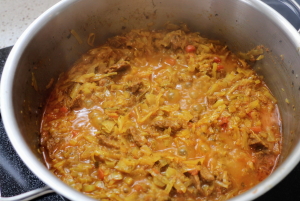
Rice
8 – On another cooking plate set the heat to high and boil the soaked rice for 5 minutes or until the rice is cooked.
Be careful and do not overcook the rice, otherwise the rice grains would be disintegrated. Also note that the under cooked rice is not tasty. A well cooked rice grain is solid but fluffy. One needs some experience to identify the optimum cooking point of a rice grain and, with the experience, you can do it by eye. It should be also noted that the cooking point of a rice grain varies form one type of rice to another. This is the basic rule; The rice is ready when the rice grains expand 2-3 times in size and appeared to float on the surface of boiling water.
10 – Drain the rice in a strainer and rinse with cold water. Taste the rice and make sure that it is not too salty. Rinse more to remove the saltiness.
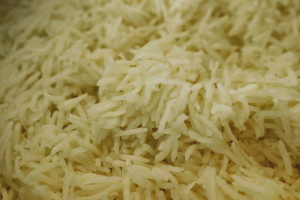
Tahdig
Tahdig is a delicious crispy layer of fried potatoes flavoured with sauce and rice. It can be also made, in a Persian recipe, with a rice layer or sometimes with pita breads or layers of flat vegetable leafs. A crispy layer of fried ingredient flavoured with the sauce.
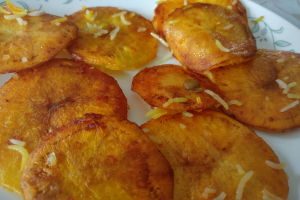
11 – Put back the skillet on a medium heat, add 3 table spoons of cooking oil, lay down the sliced potatoes evenly on the bottom, and season slightly with salt and pepper.
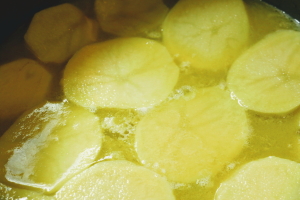
Building the meal
We will build the meal with 4 layers of rice and 3 layers of sauce one after each other over the tahdig.
12 – Spread a quarter of rice evenly over the tahdig. Make sure not to displaced the sliced potatoes.
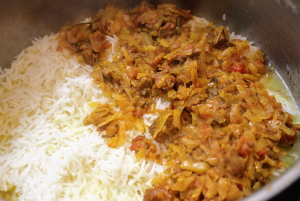
13 – Add another layer with 1/3 of the sauce spreading evenly. Repeat the layering for the rest of rice and sauce.
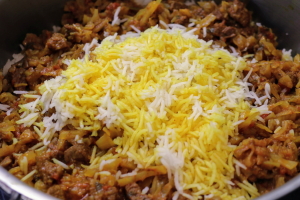
14 – Pour evenly the dissolved saffron on the last rice layer, cover the skillet, reduce the heat to low, and continue to cook for another 30 minutes. This 30 minutes time is a little imprecise and depends on many parameters including but not limited to the skillet size and its bottom thickness, the real heat produced by the cooking plate, and the thickness of sliced potatoes (tahdig). Therefore, you should keep eye on it and check occasionally.
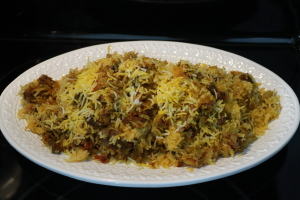
This wonderful dish is traditionally served with yogurt.

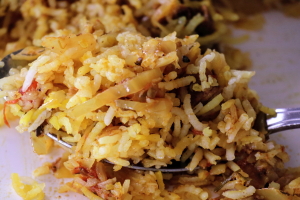


Recent Comments